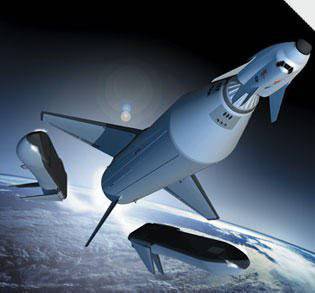America wants its rockets to fly back
 A prototype of a new type of rocket could give the USAF a ticket to and from space back and forth by 2013.
A prototype of a new type of rocket could give the USAF a ticket to and from space back and forth by 2013.The US Air Force has a vision of the future in the form of a project that implies the appearance of rockets not just reusable, but also that they can fly back to Earth and land on the runways completely autonomously.
Currently, most US military satellites are launched one-time using rockets such as the Atlas 5 and Delta 4 (in Russia, the Proton-M, Soyuz-U, and Soyuz-FG). The task of disposing of reusable accelerators installed on spacecraft is not an easy one. Two minutes after the launch, solid-fuel missiles are parachuted down into the ocean, where they are picked up by the ship. Making them suitable for flying again is time consuming and expensive.
The United States Air Force Research Laboratory (Air Force Research Laboratory) proposes an innovative program worth 33 million dollars to develop a prototype launch vehicle capable of returning to the launch pad.
The first step of the program is likely to be aimed at demonstrating a return maneuver, when the rocket will use its own engines when returning to the launch pad and planning when landing.
The first flight tests are scheduled for 2013 year.
NASA studied reverse launch boosters more than 10 years ago as part of a spacecraft modernization program, but never deeply involved in their development.
Currently, two companies already have patents for backsight boosters: Lockheed Martin, which in 2008, without any public relations, tested the prototype of the backsight booster and Starcraft Boosters, founded by astronaut Buzz Aldrin, to develop low-cost alternative carriers.
Information